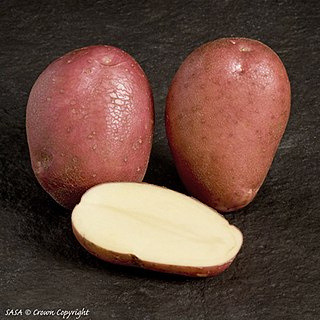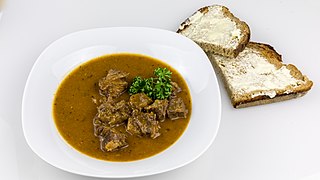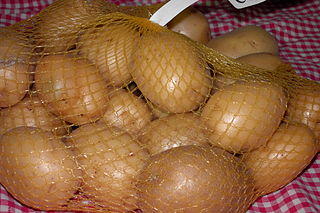Related Research Articles

Cajun cuisine is a style of cooking developed by the Cajun–Acadians who were deported from Acadia to Louisiana during the 18th century and who incorporated West African, French and Spanish cooking techniques into their original cuisine.

Mashed potato or mashed potatoes, colloquially known as mash, is a dish made by mashing boiled or steamed potatoes, usually with added milk, butter, salt and pepper. It is generally served as a side dish to meat or vegetables. Roughly mashed potatoes are sometimes called smashed potatoes. Dehydrated instant mashed potatoes and frozen mashed potatoes are available. Mashed potatoes are an ingredient in other dishes, such as dumplings and gnocchi.

Pot Noodle is a brand of instant noodle snack foods from the United Kingdom, available in a selection of flavours and varieties. This dehydrated food consists of noodles, assorted dried vegetables and flavouring powder. It is prepared by adding boiling water, which rapidly softens the noodles and dissolves the powdered sauce.

Ukrainian cuisine is the collection of the various cooking traditions of the people of Ukraine, one of the largest and most populous European countries. It is heavily influenced by the rich dark soil (chernozem) from which its ingredients come, and often involves many components. Traditional Ukrainian dishes often experience a complex heating process – "at first they are fried or boiled, and then stewed or baked. This is the most distinctive feature of Ukrainian cuisine".

Taro is a root vegetable. It is the most widely cultivated species of several plants in the family Araceae that are used as vegetables for their corms, leaves, stems and petioles. Taro corms are a food staple in African, Oceanic, East Asia, Southeast Asian and South Asian cultures. Taro is believed to be one of the earliest cultivated plants.

Potato bread is a form of bread in which potato flour or potato replaces a portion of the regular wheat flour. It is cooked in a variety of ways, including baking it on a hot griddle or pan, or in an oven. It may be leavened or unleavened, and may have a variety of other ingredients baked into it. The ratio of potato to wheat flour varies significantly from recipe to recipe, with some recipes having a majority of potato, and others having a majority of wheat flour. Some recipes call for mashed potatoes, with others calling for dehydrated potato flakes. It is available as a commercial product in many countries, with similar variations in ingredients, cooking method, and other variables.

Aligot is a dish made from cheese blended into mashed potatoes that is made in L'Aubrac region in the southern Massif Central of France. This fondue-like dish from the Aveyron department is a common sight in Auvergne restaurants.

Czech cuisine has both influenced and been influenced by the cuisines of surrounding countries and nations. Many of the cakes and pastries that are popular in Central Europe originated within the Czech lands. Contemporary Czech cuisine is more meat-based than in previous periods; the current abundance of farmable meat has enriched its presence in regional cuisine. Traditionally, meat has been reserved for once-weekly consumption, typically on weekends.

Rooster is a red-skinned, yellow-fleshed cultivar of potato, duller in colour than the 'Désirée', with floury yellow flesh. It is uniformly roundish in shape with shallow eyes making it easy to peel. It is a general-purpose potato. It can be boiled, mashed, chipped, roasted, steamed and baked. It was originally bred in 1990 at the Teagasc Oak Park Research Centre in Carlow, Ireland by Harry Kehoe. In 2004, 'Rooster' potatoes accounted for 38% of the total potato production in the Republic of Ireland.

Tatar cuisine is primarily the cuisine of the Volga Tatars, who live in Tatarstan, Russia, and surrounding areas.

Kerr's Pink is a potato cultivar in wide production in Ireland and the United Kingdom and many other countries. Although often quoted as an "Irish potato", the cultivar was actually created by J. Henry of Cornhill, Scotland, in 1907.

Oxtail soup is a soup made with beef tails. The use of the word "ox" in this context is a legacy of nomenclature; no specialized stock of beef animals are used and tails may come from bovines other than oxen. It is believed by some that oxtail soup was invented in Spitalfields in London in the seventeenth century by French Huguenot and Flemish immigrants, from the tails of animals. Different versions of oxtail soup exist: Korean; Chinese; a fried/barbecued oxtail combined with soup variation which is a popular dish in Indonesia where it is called as sop buntut; an ethnic dish of the American South which traces its lineage back to the pre-revolutionary war era; and a thick, rich, gravy-like soup popular in the United Kingdom since the 18th century. Creole oxtail soup is made from a tomato base with oxtails, potatoes, green beans, corn, mirepoix, garlic, and herbs and spices.

A great variety of cassava-based dishes are consumed in the regions where cassava is cultivated, and the ingredient is included many national or ethnic specialities.
Waxy potato starch is a variety of commercially available starch composed almost entirely of amylopectin molecules, extracted from new potato varieties. Standard starch extracted from traditional potato varieties contains both amylose and amylopectin.

The Agata is a Dutch potato variety. It is a very early maturing, yellow-skinned, yellow-fleshed variety with an attractive bright skin. Agata produces high yields of uniform shaped tubers and is known for its high pack-out. It was bred by Svalöf Weibull A.B., from the cross BM 52-72 X Sirco in Emmeloord in 1976.

Kartoffelkäse or in Austria usually Erdäpfelkäse is a spread from the regions of Bavaria and Austria. Its ingredients include potatoes, onions and sour cream.
British Queen is a variety of potato that was bred by Archibald Finlay.

Mordovian cuisine is the traditional cuisine of the Mordovians, who now live in Mordovia and surrounding areas. It consists of a variety of dishes, based on geographical, cultural and climate features of the region, with fish traditionally featured heavily.

Northern Irish cuisine encompasses the cooking styles, traditions and recipes associated with Northern Ireland. It has distinctive attributes of its own, but has also drawn heavily from Irish and British cuisines.
The Irish Lumper is a varietal white potato of historic interest. It has been identified as the variety of potato whose widespread cultivation throughout Ireland, prior to the 1840s, is implicated in the Irish Great Famine in which an estimated 1 million died.
References
- ↑ Raven, Sarah (22 January 2010). "The best potatoes". Telegraph . Retrieved 3 January 2017.
- ↑ Crane & Lawrence (1938). The Genetics of Garden Plants. Macmillan.
